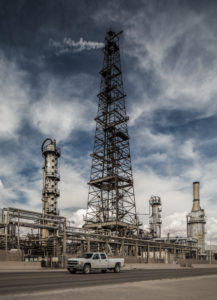
New Federal Data Show 34% Jump in Emissions from Drilling between 2016 and 2019, and an Expected Rise of About 15% by 2026
Washington D.C. — Although greenhouse gas pollution from oil and gas drilling is expected to decline this year during the recession, emissions jumped 34 percent from 2016 to 2019, and are expected to rise another 15 percent by 2026 as the U.S. economy and energy industry recover.
This is according to a new Environmental Integrity Project (EIP) analysis of the most recent available data from the U.S. Environmental Protection Agency and Energy Information Administration.
EIP has compiled a national online database of all current and projected greenhouse gas emissions from the oil and gas and petrochemical industries (chemical manufacturers that rely on natural gas or petroleum as a primary ingredient).
“The oil and gas industry is in a slump now, and there’s talk of a transition to a cleaner energy economy – but it’s very likely that greenhouse gas pollution from this sector will surge back upward as the economy improves the next few years,” said Alexandra Shaykevich, Senior Research Analyst with the Environmental Integrity Project.
“Our examination of federal data and permits approved by state and federal regulators show not only more drilling on the horizon, but a large number of planned chemical plants, fertilizer factories, and liquified natural gas (LNG) terminals, all fueled by cheap natural gas,” Shaykevich said.
Overall, greenhouse gas emissions from oil and gas drilling in the U.S. increased by 6 percent in 2019 over the previous year, rising to 137 million tons, according to recently released EPA data summarized in EIP’s analysis. That marked a growth of more than a third since the 103 million tons reported by oil and gas producers in 2016.
Greenhouse gases from refineries and chemical manufacturers both dropped slightly in 2019, compared to 2018. However, emissions from petrochemical manufacturing rose slightly (5 percent) over the longer term, from 2016 to 2019, according to the EIP report.
In 2020, oil and gas production declined by approximately 10 percent compared to the previous year, with dozens of companies declaring bankruptcy because of problems caused by overproduction of fuel and the economic downturn caused by the coronavirus pandemic.
However, permits approved by federal and state regulators for new projects over the next six years show substantial growth:
- The petrochemical and plastics sector emitted nearly 82 million tons of greenhouse gases in 2019, and could release up to 146 million tons by 2026 – a 79 percent increase, if all projects approved by regulators are built.
- Fertilizer manufacturing plants, which use natural gas as a main ingredient, emitted 39 million tons of greenhouse gases in 2019, but could release 55 million by 2026 if all approved projects are built – a 41 percent increase.
- LNG terminals released 11 million tons of greenhouse gases in 2019, but could release up to 100 million tons by 2026 if all permitted projects are built. However, an October report by EIP, “Troubled Waters for LNG,” cautioned that at least 10 of these LNG projects have been significantly delayed and may not be built, given the economic uncertainty in the industry.
- Oil and gas drilling in the U.S. produced 137 million tons of greenhouse gases in 2019, but that total could rise to 158 million tons by 2026 – a 15 percent increase – if the industry recovers as predicted by the Energy Information Administration.
For a copy of EIP’s analysis of the most recent federal data, click here.
To download EIP’s national database of greenhouse gas emissions from oil and gas infrastructure and the petrochemical industry, click here.
For the most recent EPA figures on greenhouse gas emissions in 2019, click here.
The Environmental Integrity Project is an 18-year-old nonprofit organization, based in Washington, D.C. and Austin, Texas, dedicated to enforcing environmental laws and strengthening policy to protect public health and the environment.
Media contact: Tom Pelton, Environmental Integrity Project, (443) 510-2574 or tpelton@environmentalintegrity.org


